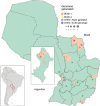Epidemiologic History and Genetic Diversity Origins of Chikungunya and Dengue Viruses, Paraguay
- PMID: 33900172
- PMCID: PMC8084490
- DOI: 10.3201/eid2705.204244
Epidemiologic History and Genetic Diversity Origins of Chikungunya and Dengue Viruses, Paraguay
Abstract
Paraguay has been severely affected by emergent Zika and chikungunya viruses, and dengue virus is endemic. To learn more about the origins of genetic diversity and epidemiologic history of these viruses in Paraguay, we deployed portable sequencing technologies to strengthen genomic surveillance and determine the evolutionary and epidemic history of arthropod-borne viruses (arboviruses). Samples stored at the Paraguay National Central Laboratory were sequenced and subjected to phylogenetic analysis. Among 33 virus genomes generated, we identified 2 genotypes of chikungunya and 2 serotypes of dengue virus that circulated in Paraguay during 2014-2018; the main source of these virus lineages was estimated to be Brazil. The evolutionary history inferred by our analyses precisely matched the available travel history of the patients. The genomic surveillance approach used was valuable for describing the epidemiologic history of arboviruses and can be used to determine the origins and evolution of future arbovirus outbreaks.
Keywords: Paraguay; arboviruses; chikungunya virus; dengue virus; genomic surveillance; nanopore sequencing; vector-borne infections; viruses.
Figures





References
-
- Pan American Health Organization. Health information platform for the Americas (PLISA) [cited 2019 Jan 29]. https://www.paho.org/data/index.php/en
-
- Vazquez C, Villalba S, Oviedo E, Gamarra ML, Oviedo E, Oviedo A, et al. Características virológicas y serológicas de pacientes con dengue grave y fallecidos por dengue durante la epidemia del año 2011 en Paraguay. Rev Inst Med Trop. 2012;77:8–18.
Publication types
MeSH terms
LinkOut - more resources
Full Text Sources
Medical

